The most important kitchen tool for vegan and plant-based cooks isn’t an Instant Pot, a slow cooker, or even a high-power blender. It’s a knife. If you are going to eat more plants, and especially vegetables, chances are you will be chopping more vegetables as well. To make the task safer, faster, and easier, it is worth having a good knife – and practicing your knife skills. But how to buy a knife? What questions should one keep in mind before shopping? Or do you even need to upgrade from the knives you already have? Welcome to my kitchen knife buying guide for vegans. But first…
Jump straight to the topics you are curious about
Do you even need to buy a knife?
There are two categories of home cooks: those who haven’t thought about their knives, and those who believe they should buy new ones. Now that you are reading this article, you might have become self-conscious and shifted from the former to the latter. But perhaps you need to choose the third, less-traveled path: maybe your knives don’t actually need to be upgraded!
Just because your knives were inexpensive – or have no pedigree – doesn’t mean they are bad ones. IKEA 365 knives, for example, are a fraction of the cost of comparable big-name knives, yet have a good reputation for design and sharpness. (I don’t own one.) This said, if your knives are flimsy, you can give yourself permission to shop around.
If you have owned your knives for more than a year, however, the odds that they need to be sharpened are close to 100%. So find a cutler in your area (search the Internet for “knife sharpener near me”), preferably one that isn’t attached to a kitchen tool store. Ask them to sharpen your knives and ask for their opinion about what makes a good knife. Knife sharpeners aren’t always extroverts but they have sharp opinions on the topic of knives and will likely be delighted to share them with you. Take their views with a grain of salt and resist the urge to buy a new knife on the spot. Bring your existing knives home and see how much better they perform… and for how long. If they are back to dull in less than three months of normal home use, it may be worth your time and money to buy a new knife or knives.
Do I need to buy a knife if my current knife feels uncomfortable?
Maybe… but maybe not. Your discomfort might come from poor knife skills or posture, leading to soreness or injury after long prep sessions. In particular, if you extend your index finger on top of the blade when chopping, you might need to work on improving your technique. Brush up on basic knife skills and practice with freshly sharpened knives. If you think you would prefer a lighter or heavier knife, then by all means set a few dollars aside in your budget and go shopping.
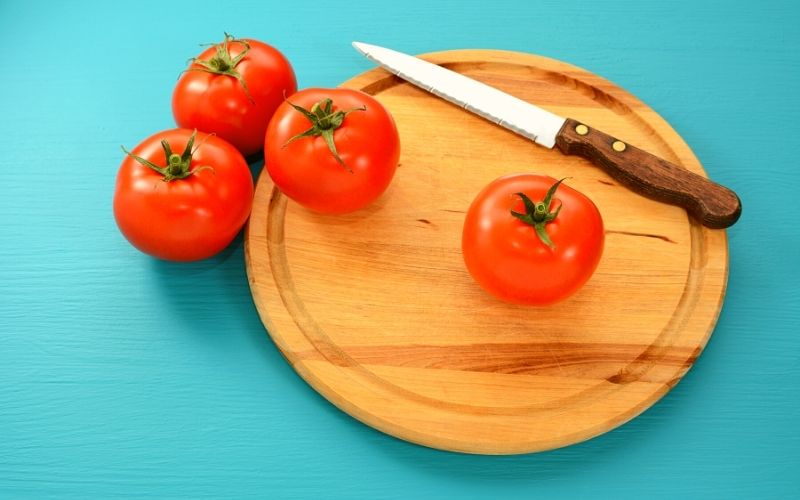
What knife or knives do I need to buy for plant-based cooking?
Plant-based cooks can get away with a smaller number of knives in their block, because fileting fava beans does not require a special knife. One also does not need to worry about moving e-coli bacteria from chicken to celery, either.
This said, when I asked chef Karen McAthy, a Vancouver-based vegan cheesemaker, former executive chef, and knife skills teacher, about the ideal number and types of knives one should have, here is what she suggested:
“There is not a single knife that’s good for all tasks. Chefs use a rule of thumb that is super useful for the home, too. One needs three knives: one serrated (for bread but also good for cutting peppers and tomatoes without bruising them and while minimizing fluid release), one good paring knife (also called petty knife) for small tasks such as hand peeling, and one good chef’s knife that can handle a broad range of tasks from chopping harder vegetables such as squash down to finer cuts like julienne.” – Chef Karen McAthy, Blue Heron Creamery.
What kind of budget should I set aside to buy knives?
Sky is the limit when it comes to knives, but from $40 to $150 there are very reasonable chef’s knife options.
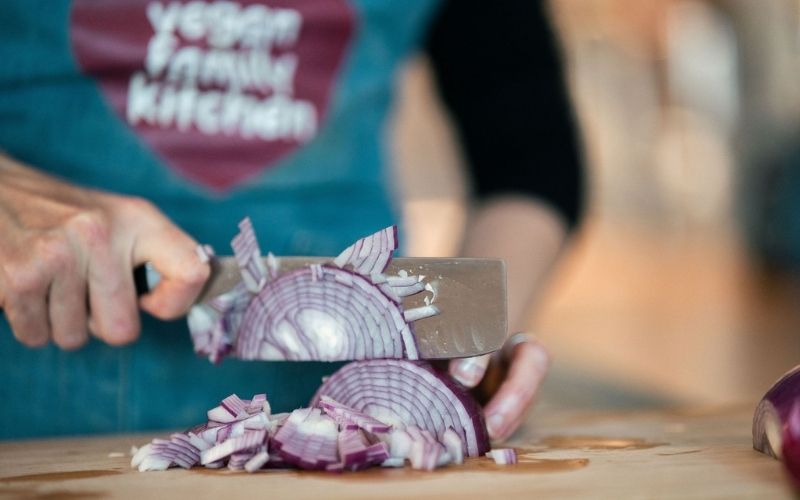
What knives do I have in my vegan family kitchen?
How many knives one should have, and of what kind, depends on many factors, including the number of cooks in the house, their skill, their comfort level, and their personal preferences. Growing up, my mother – who cooked every dinner at home including lots of vegetables – never used anything but paring knives. It was a big transition for me to get my first “proper” chef’s knife – and I couldn’t believe how much more efficient I felt with it! At the other end of the spectrum, I was shocked to get a cleaver handed to me – and no cutting board to be found – when I offered to help chop some cabbage in the kitchen of our hosts in a Vietnamese homestay. Knives and knife skills are both very personal and cultural. Different strokes for different folks!
With that in mind, here’s what works in my own kitchen right now:
- Two go-to chef’s knives that cover 80% of my chopping needs, so that two people can work at the same time.
- One all-purpose inexpensive and lightweight stamped Henkels 8″ chef’s knife with a pointy tip. It came as a set we received as a wedding gift and has been serviceable for almost 15 years now.
- One heavier Wusthof forged nakiri knife 6.5″ long with a scalloped side (air pockets) that I like for chopping a lot of vegetables. (See picture of me chopping a red onion above.) The purpose of the air pockets is to help release the vegetables off the blade when chopping. I can’t say that I have noticed a big difference with my flat-bladed chef’s knife in that regard (and as you can see in the picture, the onion is sticking to the blade – and it doesn’t bother me).
- One inexpensive Henkels 8″ serrated knife mostly used for bread and pineapple (also part of the set).
- One inexpensive and lightweight 7″ santoku vegetable knife that I bought on a trip because our vacation rental had dangerously dull knives. I keep it because it’s useful when multitasking on several projects at once in the kitchen, and because I bring it along on vacations – I won’t cry if it gets forgotten in a foreign kitchen.
- One 6″ Henkels knife (the third remaining member of the wedding set) that I use when preparing lunch boxes in the morning. I find it easier to work with on a small cutting board when my workspace is crowded during morning kitchen rush hour.
- Two smaller paring knives that my husband uses for fruit. I don’t peel many things and, if I do, I use a vegetable peeler, so I don’t pay a whole lot of attention to the paring knives. Of note, one of them was an expensive (for me) Japanese knife… and it’s my least favorite.
- One 5″ children’s vegetable knife that’s lightweight with a rounded tip and bolster. (I wish I could say more about it but my children haven’t yet used it much. Stay tuned.)
My next knife will probably be a 8″ forged chef’s knife. I like the heavier weight and longer chef’s knives are great for rocking-style chopping. Or maybe a forged 7″ santoku knife. I discovered, from working with my Wusthof nakiri, that I prefer having a slightly pointy tip as opposed to a square end.
I should probably have an inexpensive cleaver for harder squashes… but I continue to put the edge of my chef’s knives at risk instead. Cleavers just take so much space for such infrequent use! Something to keep in mind. When I upgrade my chef’s knife, I will keep the old one for squashes.
How to buy a great chef knife for plant-based cooking?
The best way to buy a knife is to go to a specialized knife or general kitchenware store where you can practice holding the knives against a cutting board. What about buying knives online? Technically, you could order a bunch of knives from The Everything Store, test them at home, and return the ones you don’t like, but that’s awfully wasteful (they likely will be thrown away), so please don’t do that.
You will want to hold many different knives in your hands to get a feel for their shape and weight distribution. Usually, stamped knives (punched out of a sheet of metal) are thinner, lighter, and less expensive, while forged knives are wider at the top and heavier. The latter are also more expensive, but it doesn’t mean that they are better. The right knife is the one that is comfortable for you and that will hold its edge. Middle-range knives from brands such as Henkels, Wusthof, Global, and Shun will all be of a high quality. The price differences are often related to the country of manufacturing. Check the fine print if that matters to you.
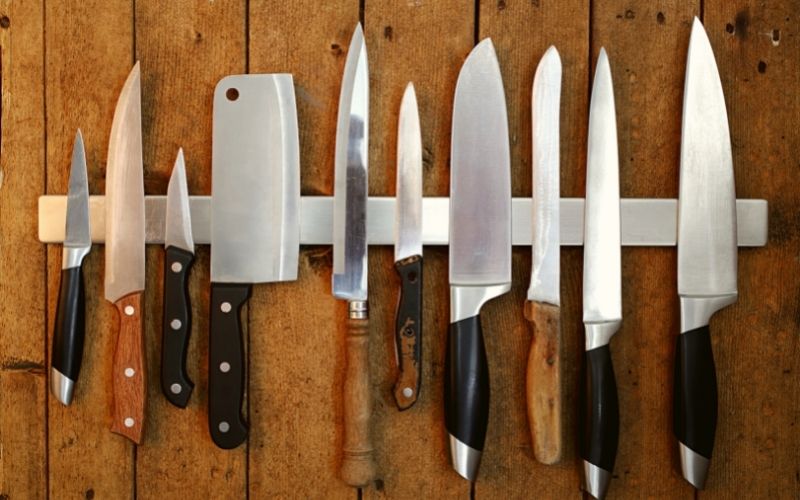
Does the material matter when buying a knife?
Eavesdropping on knife nerds taking about their obsession, whether at a knife shop or on Reddit, will spin your head and make you feel inadequate in the sharps department. From an average vegan home cook’s perspective, however, the differences may be minute and not-so-relevant to daily use. As long as you are buying your knife from a reputable knife shop, you probably can’t go horribly wrong.
The one big difference will be between metal and ceramic knives. Ceramic knives are thought to be harder and sharper, however they are also more brittle. If they get dropped or otherwise banged around, they may chip and get permanent damage. Metal knives however can (almost) always be sharpened back to life. For that reason, and because reputable ceramic knives tend to be more expensive, I have decided to stick with metal myself.
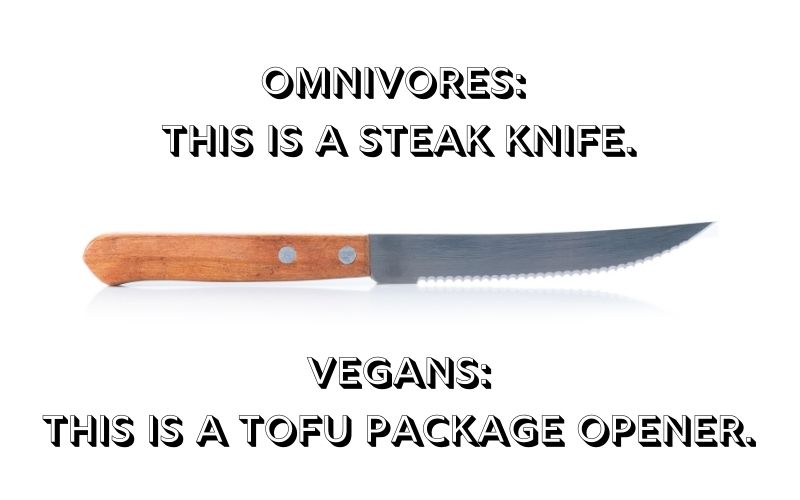
Should I buy a knife set?
As far as I can see from browsing the current offering of knife sets on popular shopping platforms, most sets include many more knives than one might like (including way too many tofu package openers, a.k.a. steak knives). Buying individual knives will help you build your tool kit progressively, based on your actual needs and with the benefit of your growing wisdom.
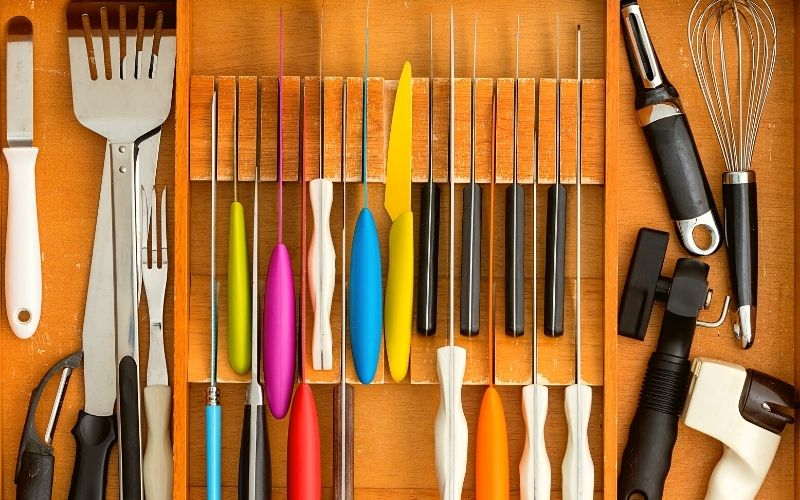
How to store kitchen knives?
Dumping your knives in a kitchen drawer isn’t a good idea. Safety concerns aside, it increases the odds of damaging their precious blades. Here are some better options to explore:
- Knife strip: A magnet knife strip is my favorite way to store kitchen knives. I have one installed on the backsplash of my kitchen and it fits all of my knives plus a pair of scissors. The knives don’t bang onto each other and the handles are all lined up so that I will not cut my fingers on the blade of one while trying to pull the other out. Do not install the knife strip inside a cabinet door due to the risk of injury. IKEA makes a great magnet knife strip for a very reasonable price. (Bonus tip: buy another one and attach it to the wall close to your front door for keys. Haven’t lost our keys since we did that!)
- Knife block: A wooden knife block is a safe way to store your knives that will also preserve their edges, however it’s rare to find one that has exactly the number and sizes of slots you need. Moreover, they use too much countertop space for my taste. Better than nothing, but a temporary measure.
- Knife inserts for drawers: If you have a big kitchen with lots of drawer space, you may opt for in-drawer knife blocks or knife inserts (pictured above). If I did have more space, I would consider those for the benefit of an even-less-cluttered visual field, but I think I still prefer the accessibility of knives on the backsplash.
Should I get a honing rod too when buying a knife?
If you don’t already have one, it’s useful to get a honing rod to improve the edge of your knives, at least once per week and perhaps every time you chop veggies. This Serious Eats video does a good demonstration but it’s even better to ask the specialist at the knife store for their advice as it specifically pertains to the knife you are buying. As for sharpening, you can certainly do it at home (with the right stones) but I prefer getting my knives sharpened professionally. Aside from knowing it will be done right, it’s an excuse to go to the knife store and admire all the beautiful (and out-of-my-price-range) sharp objects. Going for sharpenings at least once or preferably twice or thrice per year is probably ideal for regular home use, but really you have to pay attention to your edge and get it sharpened when it gets dull.
My motto in the kitchen: “never a dull moment.”
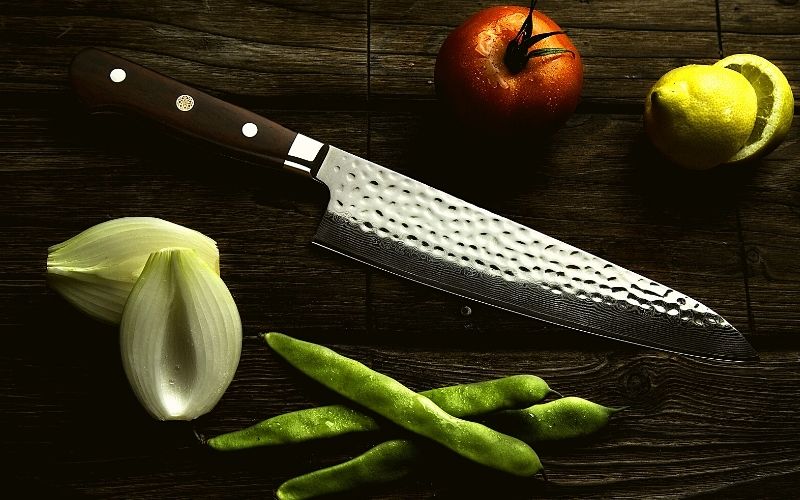
Don’t forget a good cutting board
If you a buy top-of-the-line lines forged by fairies and then use it on a glass cutting board… millions of butterflies will die somewhere. Seriously, don’t do it.
The topic of cutting boards would require a separate article, but for today let’s just say that you should go for wood (preferred) or bamboo (a solid option too), and avoid glass at all cost. Some plastic options are OK when it comes to preserving the edges of your knives, however the world doesn’t need more plastic and wood is just a superior option. Bonus: since we aren’t cooking meat, we don’t need to obsess about sanitizing the cutting board in the dishwasher. A good, quick wash with hot soapy water (don’t let it soak!), and an occasional rub with the remnants of a juiced lemon, suffice.
I personally dislike engineered-wood options (such as Epicurean) which I find too hard and loud.
My favorite cutting board is a lightweight hinoki board from Muji. It’s just the right size for typical family dinner prep and even batch cooking. It’s also light enough that I can lift it (along with everything on top) with one hand to scrape the content (with the dull side of my knife’s blade) into the pot. I’ve had mine for almost 10 years and it’s still perfectly flat, too. I just take a little sandpaper to it when I remember to do it, and oil it very lightly with mineral oil. May you be so lucky in finding your perfect cutting board for your needs! Once you have one you know you love, you may consider buying a spare… just in case.

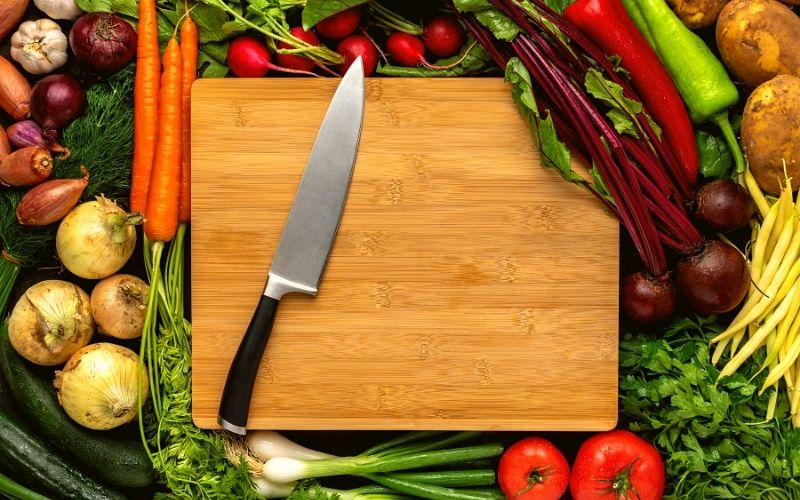

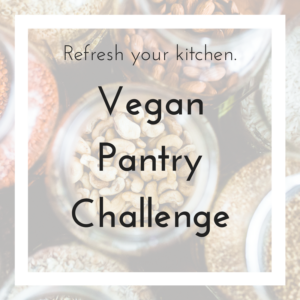
My daughter gifted me with a knife like she uses and I’ve found it works really well. I’m kinda of hanging in there with it, but had a good time getting more “educated” reading this blog post.
Thank you for dropping by Jule! There’s nothing like practice to get acquainted with a new knife…